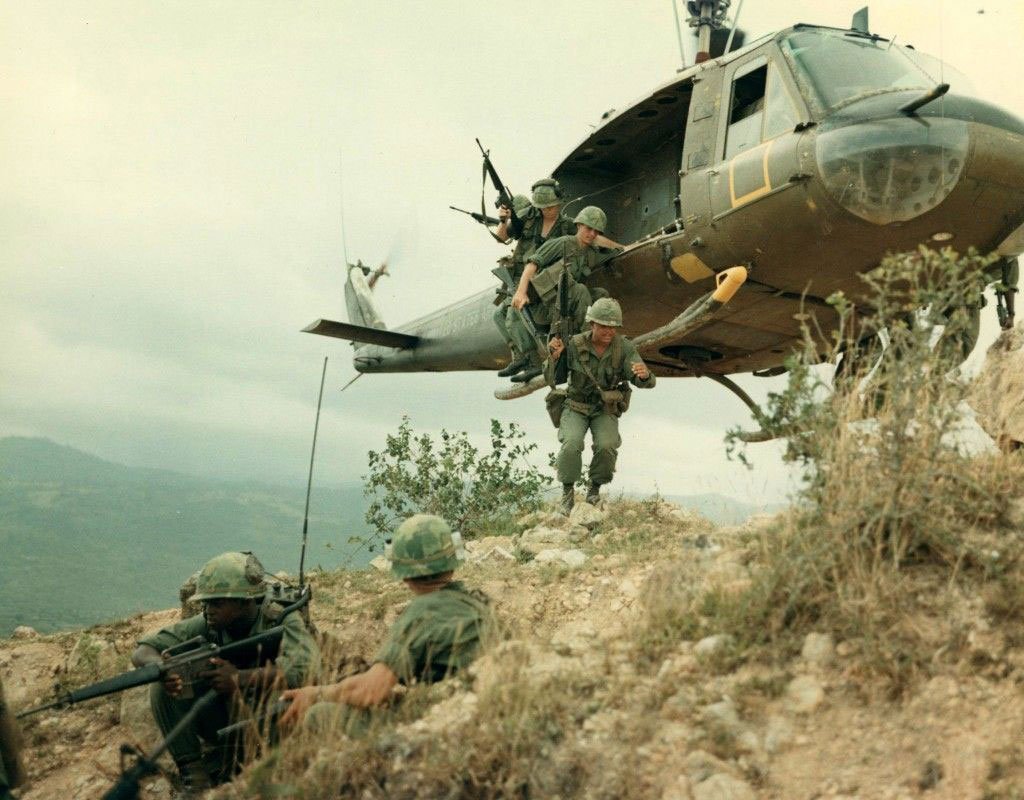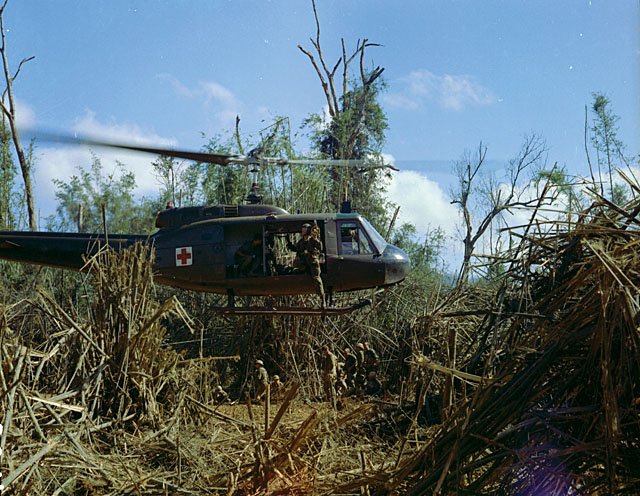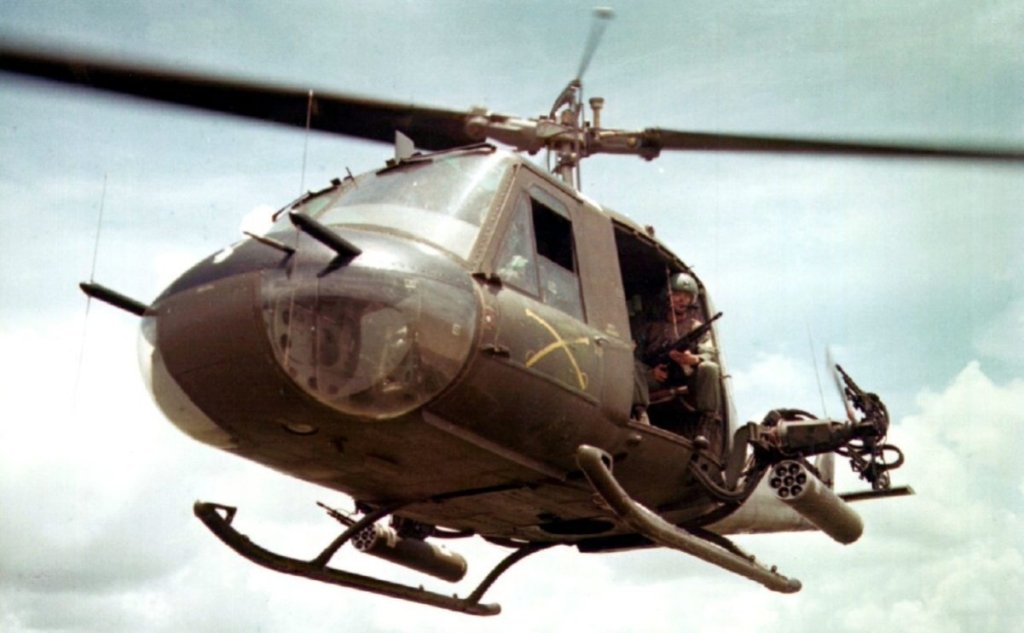The Huey Helicopter Becomes a Legend in the Jungles, Mountains, and Rice Paddies of Vietnam
Few sounds can be identified as easily as that of an in bound Huey. Few sounds can evoke as much emotion in those who needed it as much as the soldiers who relied on it.
March 20, 2024

Few sounds can be identified as easily as that of an in bound Huey. Few sounds can evoke as much emotion in those who needed it as much as the soldiers who relied on it.
As the soldiers waited for the Huey to arrive, tension hung thick in the air, mingling with the oppressive heat of the Vietnamese jungle. The men, clad in fatigues and gear, stood in a small clearing amidst the dense vegetation, their faces etched with a combination of exhaustion, anticipation, and a touch of anxiety.
Some leaned against their packs, while others sat on their helmets, their eyes scanning the skies for any sign of the approaching aircraft. The rhythmic thumping of distant rotor blades echoed through the trees, gradually growing louder, signaling the imminent arrival of their ride out of the combat zone.
A sense of urgency permeated the atmosphere as the soldiers double-checked their equipment, ensuring that everything was secured and ready for the extraction. Sweat trickled down their brows, mirroring the beads of condensation forming on their weapons and gear in the stifling humidity.
As the sound of the Huey grew closer, the men instinctively tightened their grip on their rifles, adrenaline coursing through their veins. They exchanged terse nods and brief words of encouragement, their camaraderie forged in the crucible of combat. "Here comes our ride!"
Finally, the sleek silhouette of the Huey emerged from the canopy, its distinctive shape cutting through the haze of the jungle. The soldiers tensed, preparing to board the helicopter with practiced efficiency, knowing that every second counted in this dangerous environment.

With a rush of wind and a deafening roar, the Huey touched down in the clearing, its rotor wash stirring up a whirlwind of dust and foliage. The soldiers wasted no time, sprinting towards the waiting aircraft, their movements synchronized in a well-rehearsed ballet of combat proficiency.
One by one, they leaped aboard, their adrenaline-fueled urgency tempered by the discipline instilled by months of training and combat experience. Inside the Huey, they found refuge from the oppressive heat and the looming specter of enemy threats, their relief palpable as the helicopter lifted off, leaving the jungle canopy behind.
As the Huey soared into the sky, carrying its precious cargo of soldiers to safety, the tension of the moment dissipated, replaced by a sense of fleeting respite amidst the unending turmoil of war. Below, the dense foliage of the Vietnamese jungle receded into the distance, a silent witness to the ongoing struggle for survival in the heart of a hostile land.

The Huey, formally known as the Bell UH-1 Iroquois, became an iconic symbol of the Vietnam War and played a pivotal role in various missions throughout the conflict.
Troop Transport: One of the primary roles of the Huey was troop transport. Its spacious cabin could accommodate up to 10 fully equipped soldiers, allowing for rapid insertion and extraction of troops into and out of combat zones. This capability revolutionized military tactics, enabling swift and dynamic maneuvers that were not possible with conventional ground transportation.

Medical Evacuation (Medevac): The Huey was extensively used in medical evacuation missions to airlift wounded soldiers from the battlefield to field hospitals or more advanced medical facilities. The helicopter's versatility and speed were critical in providing timely medical care to injured personnel, significantly improving their chances of survival.

Close Air Support: Armed variants of the Huey, such as the UH-1B and UH-1C models, were equipped with machine guns, rocket pods, and grenade launchers, turning them into effective close air support platforms. These gunship configurations provided fire support to ground troops, suppressing enemy positions, and conducting strafing runs against enemy targets.

Aerial Reconnaissance: The Huey was utilized for aerial reconnaissance missions, allowing military commanders to gather intelligence on enemy movements, fortifications, and supply routes. Equipped with cameras and sensors, Hueys could fly low and slow over terrain, providing valuable imagery and real-time information to ground forces.
Command and Control: Hueys served as command and control platforms, transporting military leaders and advisors to the front lines and serving as aerial command posts during operations. They facilitated communication and coordination between ground units, enabling commanders to maintain situational awareness and issue orders effectively.
Logistical Support: In addition to troop transport, Hueys were used for logistical support, ferrying supplies, ammunition, and equipment to remote outposts and forward operating bases. Their ability to access otherwise inaccessible terrain made them indispensable in resupplying isolated units and sustaining operations in challenging environments.
Insertion and Extraction of Special Forces: Special operations forces, such as Army Special Forces (Green Berets) and Navy SEALs, frequently utilized Hueys for insertion and extraction during clandestine missions behind enemy lines. The helicopter's speed, agility, and low radar signature made it well-suited for inserting small teams into hostile territory and extracting them upon completion of their objectives.
Overall, the Huey's versatility, reliability, and adaptability made it one of the most important assets in the U.S. military's arsenal during the Vietnam War. Its widespread use across various mission types contributed significantly to the overall effectiveness of American and allied operations in Southeast Asia.

UH-1Ds extract troops of A Company, 2nd Battalion, 8th Cavalry during a search and destroy mission in October 1967.
One could write volumes about the bravery, resilience and trials of the crews of the Hueys of Vietnam, this story will be constantly expanded on as we gather more and more stories, you can email us directly with any photos or stories you may have.


